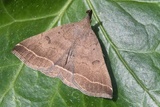Polypogon plumigeralis (Hübner, [1825]) Species
Last modified: Nov. 12, 2025, 6:52 p.m.
This species was mentioned for the first time in Belgium (WV) in 2000. This rare migrant – and perhaps transitory resident – was till 2009 only known for the provinces of WV, OV, HA and AN. After 2009 it was observed throughout Belgium. Nowadays a fairly common species, but mainly in the northern part.
This species is considered Least Concern according to the IUCN Red List category for Flanders 2023.
Details
- Classification
- Family: Erebidae > Subfamily: Herminiinae > Genus: Polypogon > Species: Polypogon plumigeralis
- Vernacular names
- Gepluimde snuituil (NL), Plumed Fan-foot (EN), L'Herminie de la Garance (FR), Steppenheiden-Spannereule (DE)
- Synonyms
- Polypogon crinalis (Treitschke, 1829)
- First mention in Belgium
- Vanholder B. & Bolland F. 2002. Pechipogo plumigeralis: een nieuwe soort voor de Belgische fauna (Lepidoptera: Noctuidae). — Phegea 30(3): 81–83. On page 81 (as Pechipogo plumigeralis (Hübner, 1825)). view page
- Status
-
Native
Distribution
Bionomics
This species hibernates as a larva and pupates in plant debris. The moths come to light.
No pictures yet!
Flight periods
The adults fly in one generation a year from late June to August and occasionally until late September/October.





